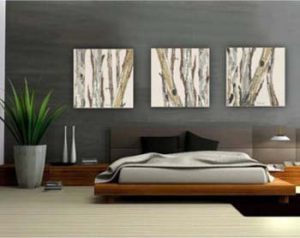
Large Art Commands Attention
Using a large piece of Art for Staging can create a show stopping centerpiece for any room. It directs the eye and commands attention, it sets the tone and personality adding to the overall feeling of the space.
A FEW GUIDELINES
If you’re using art for staging, it should compliment the style of the home. Abstract pieces such as flowers and landscapes are safe while making a statement.
Repeat colors that are already in the room in the artwork. Even if you’re working with metals or neutral colors find a common color thread that you can repeat. Hang the art near furniture helping to move the eye around the room.
When deciding what wall to hang the artwork, always think about the first impression of the room and the angle photos will be shot from. Mirrors can be a good choice to reflect views and add depth to a room.
The size will depend on the size of the wall or piece of furniture the artwork will hang above – it should be proportionate. Over-sized art should be hung on the largest wall that’s the most visible when you enter the room.
Want to draw attention to the high ceilings? Choose two – three pieces and walk them up the wall drawing the eye up.
Multiple pieces hung in a grid can give the same impact as one large piece. Keep about 2 – 3 inches between frames.
Size matters, a rule of thumb is to have the art fill two-thirds to three quarters of the wall. For contemporary art, bigger is better to maximize the impact.
How high should you hang art? The center of the piece at eye level has always been the standard. Most art galleries hang their art up 58″ from the floor. But this rule doesn’t necessarily apply for all pieces in all rooms. For instance if the room will be used mostly for sitting, hang your art lower to keep it at sitting eye level. When hanging above a sofa or other piece of furniture, keep the bottom edge six – twelve inches above the furniture.
Art like any other accessory can be overused in a staged home. As with anything, when selling your home, less is more.
